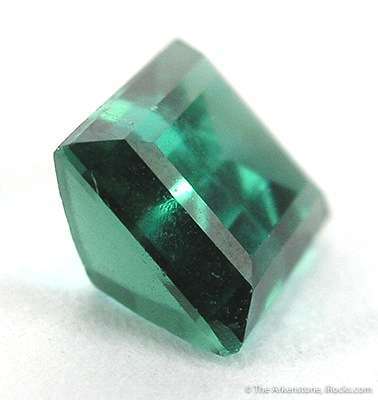
How to Measure Gem Girdle Thickness
Cutting the right size girdle for a gem can be difficult. Learn how girdles and jewelry settings affect each other and how best to measure girdle thickness.
5 Minute Read
The Gemstone Girdle
So, what purpose does the girdle of a stone serve? Simply put, faceters cut girdles on faceted gems so they can be set in jewelry. There are some other reasons, too, but this is the main reason.
For the gem to set properly, a girdle should be level, strong, and neither too thin nor too thick. (Easier said than done for a new cutter, I know). Let's examine the setting process more closely. If you understand this process, you'll better understand how to judge girdle thickness.
Setting a Gem in Prongs
When placing faceted gems in prong settings, jewelers will typically cut notches in the prongs, shaped to match the outline of the stone's girdle as closely as possible. (Sometimes, prongs may have pre-cut notches, depending on the setting). The closer the notches to the shape of the girdle, the stronger the setting when done. See the graphic to the right.
Once the notches are cut, the jeweler gently bends the metal prongs around the girdle to secure the stone in the setting. So, as you can see, girdle thickness plays an important role in gem setting.
If the girdle is too thick, the notches will have to be large and deep. This will likely weaken the structural integrity of the prongs. On the other hand, if the girdle is too thin, the notches will have to be small. They likely won't hold well.
Study Blank Settings
You can easily find blank prong settings (without stones) online or at jewelry supply stores. Look at the prongs and pre-cut notches and visualize the girdle thickness you need. Remember, you'll probably have to enlarge the notches to fit them to a specific stone before setting. Therefore, your final notches will be somewhat different and larger than the originals. However, a little research on your setting materials will give you a better idea of the girdle thickness you'll need.
Girdle Observation Tips
If you're evaluating a finished gem, here are a few pointers.
- Examine the gem from a normal reading distance.
- Put down your loupe and look at the stone's girdle with your naked eye. (Viewing the girdle through the loupe will give you a false sense of size).
Is the Girdle Too Thin?
Does the girdle look sharp, like it might cut you? That's the simplest way to tell it's too thin.
Is the Girdle Too Thick?
Does the girdle look roundish? If so, it's too thick.
What Difference Does Girdle Thickness Really Make?
Sooner or later, a too-thin girdle will chip. Since even gently bending prongs into place requires a fair amount of pressure, such a girdle runs a high risk of chipping. If the jeweler doesn't damage it during setting, the person wearing the finished jewelry will. Weak and vulnerable, a too-thin girdle constitutes the most serious cutting mistake a faceter can make, in my opinion.
A too-thick girdle will make the stone hard to set. It provides little purchase for the prongs to grip. Although better than too-thin, cutting too-thick girdles in general isn't a good idea. Some faceters cut thick girdles to gain some carat weight, especially when the stone has too much crown depth. Don't fall into this habit. Believe me, jewelers won't thank you for too-thick girdles. Cut the girdle to the appropriate thickness and charge a little more for the stone, if you need to.
An uneven girdle will make the stone difficult to set securely and level. The notches on each prong will have to be cut differently. Setting a stone with an uneven girdle will take many extra hours. The jewelers dealing with the uneven stones you cut won't think kindly of you.
Don't think this matters? I've actually sold my finished gemstones to many jewelers over those of competitors because mine had correct girdles. They're just easier to set, and time is money.
(Editor's note: To learn how girdle thickness can affect diamond cut grading, read this article).
Girdle Thickness Percentages in Gem Designs
You may have noticed that in almost all faceting designs, the girdle thickness is given as 0.02. The formula is:
H/W = (P+C)/W+0.02 = Depth of Design
Or, Height/Width = (Pavilion Height + Crown Height)/Width + 0.02 = Depth of Design.
Basically, the GemCad program uses this arbitrary figure (2% of a finished gem's height) as a standard for calculations. In my opinion, the 0.02 girdle doesn't have much practical application in the real world. It serves primarily for calculating designs and sometimes for contest cutting. Therefore, I don't worry about this standard in my everyday gem cutting.
How do You Get a Decent Girdle Thickness?
So, how do you get a girdle that's not too thin, not too thick, but just right? Well, here's a concrete way to visualize girdle thickness.
Below, you have an American standard wire and metal gauge. It's marked from 1 to 30 gauge on one side and in thousandths on the other. Although you can find other types of gauges and calipers, this inexpensive tool is a jewelry industry standard.
Ordinarily, to determine the thickness of a particular metal or wire, you'd slip it into the slots until you found one just snug enough to fit, not too tight or too loose. That would mark the thickness (or gauge) of the metal or wire.
To judge gem girdle thickness, hold the gem next to the gauge so that you can compare the girdle to the slots. Basically, the gauge will give you a good, constant visual reference for thickness.
For example, the gem I'm holding in the photo below is an 9.2 mm square aquamarine. The girdle is about 0.025 to 0.028 gauge thick. That's pretty close to my standard girdle thickness, on average. (I tend to cut stones in the 1 to 10 carat range, mostly 2 to 6 carats overall).
Generally, my girdles fall between 0.020 and 0.040 gauge thick. You can see that range in the photo below. Of course, I may make adjustments for extra large or small stones.
Metal or Plastic Gauges?
If you use a metal gauge, like the one in the photos, don't touch the gem girdle with it. The metal could chip the stone
You could use plastic gauges for this. In fact, for judging girdle thickness, they're much safer. However, bear in mind they will wear out, especially if you also use them to measure metals and wires. Also, heat will warp them. (Around a jeweler's or faceter's bench, they may end up on fire).
Learning to Judge Girdle Thickness
Novice faceters can use a gauge to get a better visual sense of girdle thickness. Measure what you cut and then see how it fits into prong settings. You'll eventually recognize the sizes you need to cut. With enough experience, you'll reach the point where you'll rarely use the gauge. Just keep working at it and you'll get the hang of it.
One final piece of advice for novices: if you can, err on the thicker side rather than the thinner side.
Related Articles
Working with Ceramic Lap
Kraftwerks Event 2004
The Spectra Ultralap
Buying Faceting Add-Ons
Latest Articles
800 Years of Mogok: A Celebration in Tenuous Times
What is the Average Gemstone Faceting Yield?
Pyroxmangite Value, Price, and Jewelry Information
How to Identify Emerald Simulants and Synthetics
Never Stop Learning
When you join the IGS community, you get trusted diamond & gemstone information when you need it.
